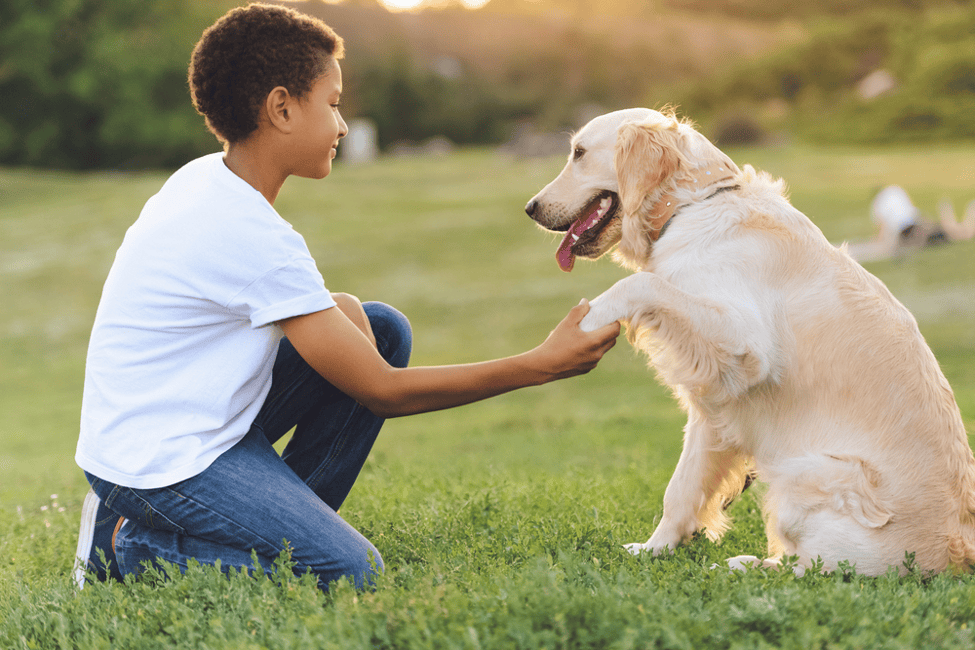
by Diana Hembree
More than 163 million cats and dogs currently make their homes in backyards and living rooms across America. That adds up to a lot of dug-up flower beds, vet bills and ruined upholstery. It also adds up to a lot of happiness.
To begin with, furry companions can promote mental health and resilience in children across the board, according to a 2015 study published in the Journal of the American Board of Family Medicine.
Not only do children with pets demonstrate more empathy, self-esteem and problem-solving, the researchers found, they showed greater trust, community feeling, sense of safety and self-confidence. In addition, “Pets provide comfort and act as confidants” for children, according to the authors.
For youngsters suffering from Adverse Childhood Experiences (ACEs), a pet can help support healing from trauma by boosting their sense of safety, connection and resilience.
Children and adults suffering from trauma “may develop connections to animals that provide emotional support and a sense of protection” during times when their nervous system is on high alert, writes Ricky Greenwald, PsyD, on the website of the Trauma Institute and Child Trauma Institute in Northampton, Massachusetts. Animals “help build up resilience in the face of adversity,” he concluded.
For children suffering the aftermath of trauma or ACEs, pets may help lower their stress: Studies have linked pets to reduced blood pressure in both children and adults.
To Cameron Woo, editor of the well-regarded dog magazine The Bark, this all makes good sense. “Especially when there’s an only child, a dog can really round out a family and serve as sort of a canine brother or sister,” he said.
“Dogs are such a calming influence. Often a dog is a child’s first responsibility – feeding him, taking him on walks, teaching him tricks, brushing him or whatever is age-appropriate. This can definitely build a child’s self-confidence. Having a great companion who goes everywhere with you and is loyal, loving and non-judgmental can also teach a child a lot about healthy relationships.”
For children suffering the aftermath of trauma or ACEs, pets may help lower their stress: Studies have linked pets to reduced blood pressure in both children and adults. In one experiment, children were found to have lower blood pressure “in the mere presence of a dog, even though they didn’t interact with the animal,” wrote a researcher in an article from the Western Journal of Medicine.
“Stroking or petting an animal appears to lower both blood pressure and pulse rate in both the human who is petting and the animal being petted,” the authors reported.
One way pets may relieve stress and anxiety in children (and adults) is by triggering the activation of the so-called “love” hormone oxytocin, according to the study published by the Journal of the American Board of Family Medicine. Its effects include lowered anxiety levels and reduced stress, blood pressure and symptoms of depression, along with increased social interaction, self-confidence and learning, the researchers noted. According to the journal, “Oxytocin concentrations in dog owners increase significantly when their pets gaze at them.”
Kids need more exercise? There’s a dog for that

And dogs offer a special side benefit: Keeping kids physically fit. That is especially important for kids with ACEs because exercise can lower anxiety and depression.
Researchers first noticed dog-walking benefits among adults: Urban dog owners walk almost twice as much as neighbors without pet dogs, according to a study published in the American Journal of Preventive Medicine. Regular walks around the neighborhood mean aerobic exercise, a chance to mingle with neighbors, and — in many cases — reduced weight.
In fact, people in a University of Missouri study who walked “loaner” dogs 20 minutes daily for 50 weeks, for example, lost an average of 14 pounds – more than many people lose on popular diet plans.
These fitness benefits extend to children, research suggests. A study in the American Journal of Public Health, for example, found that children who had dogs devoted more time to vigorous physical activity and took more steps every day than children without pets. Outdoor play was also more common among kids with dogs, according to an article in Preventive Medicine.
And if your teen is spending a lot more time on social media or video games than sports, a family dog may be just what the doctor ordered. A study from the University of Virginia at Charlottesville found that teens with dogs got more exercise than their peers without pooches.
Choosing the right pet
Of course, the wrong pet could end up becoming the exact opposite of a stress reliever. Before bringing home an animal, choose carefully and consider how much attention, space and time you can give to a new companion. Perhaps ask yourself if you’re ready to care for your pet all its natural life: Some researchers and vets have found evidence that dogs can suffer trauma, too – something that may come as no surprise to many pet owners. Since dogs bring us undying love and loyalty, it’s only fair that we repay them in kind.
A couple of cautions: Babies, toddlers and young children should not be left alone with a dog, even a small one, and “non-aggressive” breeds are a much safer choice for you and your neighbors. It’s also good to teach your children how to approach a new pet. They may want to run up and hug his or her neck, but that might elicit a nip from a scared pooch. Professional pet sitter Kristen Carr advises children to approach a dog slowly, from the front, then put out a hand for them to sniff. If all goes well, they can give a friendly scratch under the chin, then pet the dog on the head.
If you choose well, the kids and your new pet will soon be inseparable. You’ll have a friend for life – and you and the kids don’t need a clean bill of health to see the value in that.
Chris Woolston and LimeHealth contributed additional reporting and writing to this story.
References
Allen K et al. Cardiovascular reactivity and the presence of pets, friends, and spouses: The truth about cats and dogs. Psychosomatic Medicine; 64: 727-739.
Christian H, et al. Dog Walking is Associated with More Outdoor Play and Independent Mobility for Children. Preventive Medicine; 67: 259-263.
Dwiwardani, C., Hill, P. C., Bollinger, R. A., Marks, L. E., Steele, J. A., Doolin, H. N., … & Davis, D. E. (2014). Virtues develop from a secure base: Attachment and resilience as predictors of humility, gratitude, and forgiveness. Journal of Psychology & Theology; 42, 83-90.
Fitzgerald, Faith T, MD. The Therapeutic Value of Pets. Western Journal of Medicine; 1440(1):103-5.
Hudgson, K., et al. Pets’ Impact on your Patients’ Health: Leveraging Benefits and Mitigating Risk. Journal of the American Board of Family Medicine; 28 (4): 526-534/
O’Rourke K. Pets, spouses compete for the title of best stress relievers: Pets win. American Veterinary Medical Association News. https://www.avma.org/javma-news/2002-11-01/pets-spouses-compete-title-best-stress-reliever-pets-win
Sable, P. Pets, attachment, and well-being across the life cycle. Social Work; 40, 334-341.
Diana Hembree is a science writer for the Center for Youth Wellness. She is an award-winning journalist who has worked at Time Inc., the Center for Investigative Reporting and the Energy Bioscience Institute and has written or edited for Forbes, HealthDay, the Washington Post, PBS Frontline, Vibe and many other places. She can be reached at stresshealthnow@centerforyouthwellness.org.





